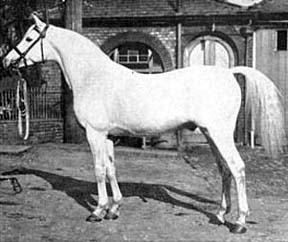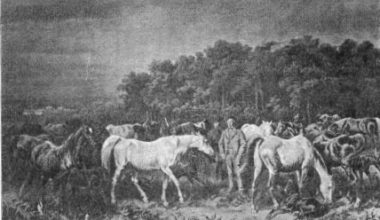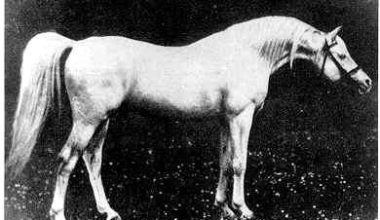There are many ways to judge a horse. Some of the more common considerations include conformation, size, temperament, athletic ability and genetic “potency.” These are normal criteria for evaluating all breeds of horses.
However, within the Arabian breed, another criterion takes precedence over all others: pure blood. A pure or asil Arabian horse is defined by its exclusive origin among the Bedouin tribes of Desert Arabia, the creators of the Arabian breed. Bedouins accepted a horse as pure if they had reliable information on its strain, sub-strain and Bedouin breeder. Conversely, Bedouins removed horses from the breed for two distinct reasons: mixed blood and unknown origin.
Mixed blood. Bedouins used the term hajin to generally describe any horse that contained non-Arabian blood mixed with Arabian blood. Horses of mixed blood are by definition not pure. Any descendant of a mixed blood horse is also of mixed blood so the status of hajin is not reversible. A hajin horse does not have a strain connecting it to the community of Arabian horses. How do we know a horse has mixed blood? The most obvious way, but not the only way, is that the owner of a horse identifies non-Arabian blood in a horse’s pedigree. In the case of foreign blood, there is no benefit of the doubt. If a horse had confirmed or probable non-Arabian blood in its pedigree, Bedouins would no longer consider it an Arabian.
Unknown origin. Bedouins used the term kadish to refer to a horse with unknown origin. This concept is a bit harder to understand, peculiar to the Arabian breed and open to interpretation. It is reasonable for some to consider a certain horse pure while others to consider the same horse kadish. After a period of time, and based on an individual or collective judgment, a horse without adequate information on its Bedouin origin is kadish. The status of kadish is not reversible. Horses of unknown origin can only produce horses of unknown origin. Bedouins did not consider horses of unknown origin Arabian.
Any single ancestor that is of mixed blood (hajin) or of unknown origin (kadish) is enough to disqualify any descendant of that horse as a pure Arabian, regardless of the number of generations of separation.
How to judge the stallion Skowronek, said to be Arabian, born in Russia in 1909, and bred by an ethnic Pole? Perhaps the most revealing way to judge him is the way his home country judged him. Were the Russians and Poles aware of the criteria described above in 1909? What did they consider a pure Arabian? How much Arabian blood did Skowronek have?
In the century prior to Skowronek’s birth, the equine experts of the day writing in Russian, Polish, German, French and English clearly understood the concept of mixed blood. If you bred horses that were considered “Oriental” in Europe between 1850 and 1910 and were literate in Russian, Polish or German then it is highly likely you knew that Skowronek’s ancestors were horses of mixed blood. Primary sources dating from 1799 and secondary sources from 1860 show that Skowronek had numerous non Arabian ancestors.
Skowronek’s country of birth, Russia, considered pure blood the governing characteristic of the Arabian horse. The 1903 Russian Arabian Stud Book established written criteria that placed horses into two separate sections. Part 1 for “pureblood Arabian horses of exclusive Bedouin origin,” required horses listed to have reliable information on their strain, sub-strain, Bedouin breeder and the chain of custody of the horse from the Bedouin breeder to the owner in Russia. Part 2 for “horses of Arabian blood and equine profiles of farms or farm’s departments of exclusively Arabian direction” had no requirement for entry and contained horses of mixed blood (hajeen) and horses without the necessary information on their Bedouin origin (kudsh). Skowronek’s dam, Jaskólka born in 1891, is listed in Part 2.
How much Arabian blood did Skowronek have? The 1903 Russian Arabian Stud Book provides an explicit method to evaluate each of Skowronek’s root ancestors, as they would have been judged in Skowronek’s country of origin at the time of his birth. The original ancestors that meet the requirements as “pureblood Arabians” in Part 1 of the 1903 Stud Book are 100% Arabian. The others are 0% Arabian. From this basis we can calculate Skowronek’s percentage of Arabian blood.
The criteria for judging Skowronek are unambiguous, and the facts are overwhelming. The primary and secondary source evidence published prior to 1910, which has been professionally translated, includes approximately 250 pages of English text based on original Russian, Polish, German and French documents. This information will be published on this website, the FaceBook page Skowronek – A Partbred Arabian Horse, as well as this blog.


